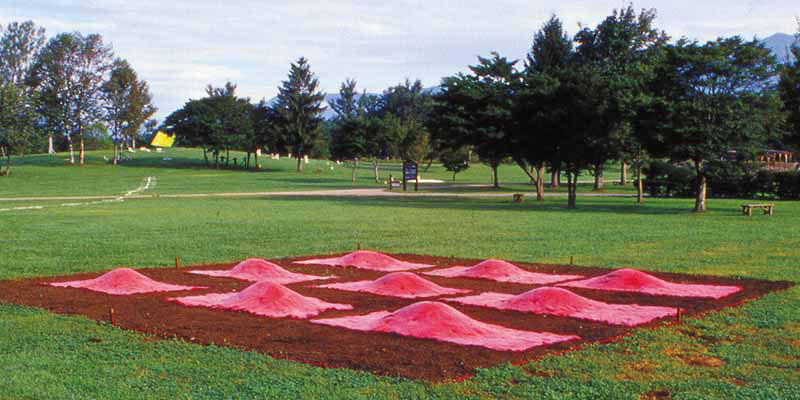
前・後 Front / Back 2000
小岩井農場の一日は、今日も一世紀前と変わらず始まり、新たな記憶を重ねてゆく。
岩手山麓の開墾は、日の出と共に、人と馬がひとつになって行われた。畑が作られ、牧草地が広がっていった。
岩手の気候風土は人を育て、人は原野を緑に変え、緑は動植物を育てる。人は大地を育み、大地は人を育む。
9枚のフェルトは、人、穀物、建物、動物、道具、水、植物、土壌、記憶の9つを象徴した衣服であり、羊を育んだ牧草の種がまかれ、2ヶ月後には一面牧草が覆った。羊の身体を覆っていた羊毛も、約2年かけて土へと戻り、そこには再び以前と変わらぬ緑の草原が続き、新たな生物を育んでゆく。
A day in Koiwai farm begins as it did a century ago and ends by accumulating a new memory.
The people who cultivated the piedmont of Iwate started to work at dawn, and worked hand-in-hand with horses. They plowed through the field and pastures prevailed. Iwate's nature and climate nurtured the people, and people transformed the moors into lush green land. The green then fostered animals and plants. People cultured the soil, and the soil cultured the people.
Nine pieces of felt are clothes that represent people, cereal, building, animal, tool, water, plant, soil, and memory. We sowed the seed of grass that feeds sheep and, in two months, the field was covered with grass. The wool that covers sheep's body would return to soil in two years. The green pasture would continue as it did before, and tend a new set of animals and plants.
素材:羊毛、染料、大地
小岩井農場まきば園 (岩手) / Field project in Koiwai 眞田岳彦展 Wool in Wool 2000